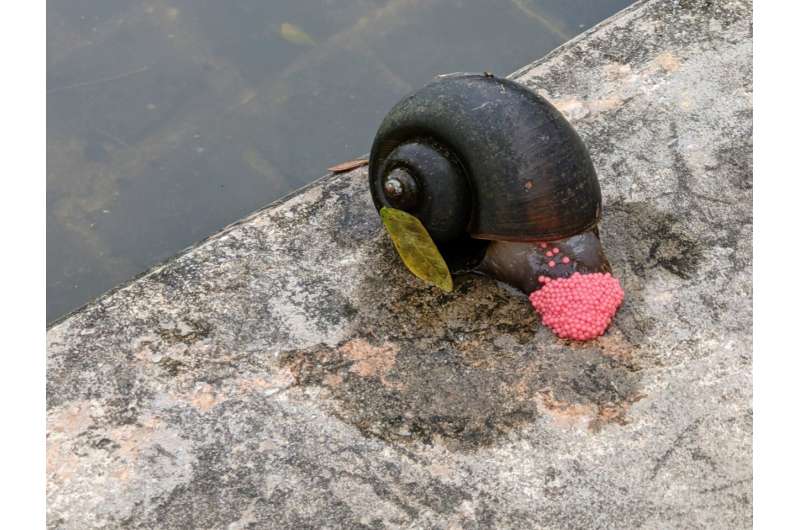This article has been reviewed according to Science X's editorial process and policies. Editors have highlighted the following attributes while ensuring the content's credibility:
fact-checked
peer-reviewed publication
proofread
Apple snail invasion could be 'disastrous' for rice production and food security in Kenya, study reveals

An invasion of apple snail could be "disastrous" for rice production and food security in Kenya as well as other rice growing regions across Africa, according to a new CABI-led study published in the journal Pest Management Science.
The scientists, led by Kate Constantine, Project Scientist at CABI, highlight apple snail (Pomacea canaliculata) as a serious problem in Kenya's Mwea Irrigation Scheme. Extension agents stated apple snail is one of farmers' top five complaints and agro-dealers reported that 70% of complaints on a daily basis were due to apple snail.
Household surveys and focus group discussions with smallholder farmers, alongside key informant interviews, revealed the invasive species—which is native to South America—reduced rice yields by up to 14% and net rice income by up to 60% for farmers experiencing moderate levels of infestation (>20% of cultivated area affected).
The researchers stress that it is "essential" that strategies to limit the spread of apple snail are rapidly implemented. This includes, the scientists say, raising awareness, outreach and capacity building at all levels of the farming system.
In Kenya, around 300,000 small-scale farmers are involved in rice cultivation, not only providing labor but also earning their livelihood, with the Mwea Irrigation Scheme in Kirinyaga County accounting for 80-88% of the country's rice production.
The Kenyan Ministry of Agriculture & Livestock Development predicts that rice consumption will reach 1,292,000 tons by 2030. As a result, rice has been identified as a priority value chain in the National Agriculture Investment Plan (NAIP 2018-2028) and National Rice Development Strategy-2 (2019-2030), which aims to transform Kenya's agriculture towards sustainable food and nutrition security and socio-economic development.
However, there is considerable untapped potential to expand rice production in the country, with estimates suggesting a production potential of up to 1.3 million hectares of irrigated rice.
Constantine said, "Rice production has seen consistent growth in demand over the last three decades, with its potential to improve rural livelihoods being widely recognized. In Kenya, rice is the third most important cereal grain after maize and wheat, and its consumption is increasing at a faster rate than production."
"However, rice farmers in Mwea face various challenges, including water shortages, rice blast attacks, high input costs, low land productivity, machinery shortages, bird damage, poor infrastructure, and a lack of resilient and acceptable rice varieties."
"The recent introduction of apple snail has added to these challenges, posing a serious threat to rice production in the region and potentially across Africa."
Fernadis Makale, co-author, added that, in response to the apple snail threat, a Multi-Institutional Technical Team (MITT) drawn from various national and international institutions has been established to lead management efforts and provide consolidated advice to farmers on how to effectively manage the pest.
The researchers found that farmers reported increased use of chemicals to try and combat apple snail as well as the costly practice of hired labor to physically remove egg masses and snails.
Makale said, "The negative impacts will only increase over time as apple snail continues to spread. It is a call for urgent action. There is a rapidly narrowing window of opportunity for potential containment, or possibly even eradication, before apple snail becomes widespread in Kenya, and the only feasible option will become management, with its associated high economic, livelihood and environmental costs."
The scientists argue that in the absence of action to mitigate spread, the consequences could be disastrous, not only for farmers in Mwea but further afield. For example, if the snail spreads into the irrigated rice-production area of Ahero, at the edge of Lake Victoria, rice production in Tanzania and Uganda would be threatened, and from here inevitable further spread would occur.
"There are also serious food security implications as apple snail threatens any progress that has been made towards Kenya's self-sufficiency in rice production," Constantine added.
More information: Kate L. Constantine et al, Assessment of the socio‐economic impacts associated with the arrival of apple snail (Pomacea canaliculata) in Mwea Irrigation Scheme, Kenya, Pest Management Science (2023). DOI: 10.1002/ps.7638
Journal information: Pest Management Science
Provided by CABI

















